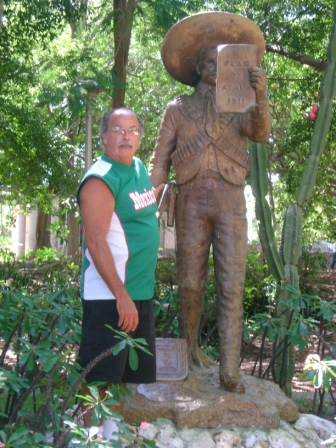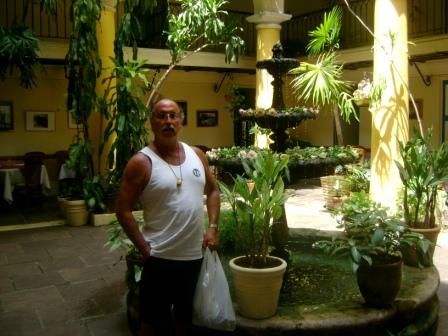Chicano in Cuba, Settling In
By Patrick Velasquez

HAVANA TIMES, Oct. 8 – I arrived with my colleague, Agustin Orozco, in Havana near midnight on September 2nd. Our long ride through the darkness of Havana led us to the Hotel Sevilla in Havana Vieja. Too restless to sleep despite our journey of over twelve hours, we ventured onto the streets of Old Havana.
Less than one block from our hotel, we were accosted by two of the Cubans we jokingly labeled as “zombies”– jineteros, the ubiquitous “pimps” who aggressively offered us prostitutes, illicit cigars (probably made of cow dung), and other forbidden vices. As Chicanos familiar with the dynamics of inner-city street life, Agustin and I beat a fast retreat to the hotel and crashed for the night.
The next morning, we rose early to have breakfast at our hotel. Despite our mutual desire to enjoy an international experience without the presence of overbearing tourists, we found ourselves completely surrounded in the buffet by European tourists no doubt in search of exotica.
We shrugged off this unavoidable negative invasion by “gringo” tourists and caught a taxi to our conference in Miramar, about twenty minutes West of Havana Vieja.
In actuality, the “conference” we attended was called a “taller” (workship) or “Paradigmas Emancipatorias” (roughly translated as emancipatory theories and strategies) held at a center for Cuban workers.
Despite the brutal heat of Havana in September (several Cubans told us that we experienced record heat and humidity), the conference’s small group sessions were held outside. Agustin and I found ourselves in small “platicas” (discussions) with conference attendees representing social justice projects throughout Latin America.

Some of the projects smacked of patronizing missionary work (e.g. citizens from Spain working in “poverty projects” in Latin America) but most reflected sincere, grass-roots efforts to develop viable, collective solutions to conditions of material poverty and political oppression.
Throughout the three days of the conference, we heard about profound social justice projects originating from marginalized communities – an effort to enact collective responses to material deprivation in a working-class Cuban community (Pogoliti in the municipality of Marianao), a feminist movement in Guatemala, a “caracol” project to garner support for indigenous peoples in Chiapas, Mexico, a courageous youth organization called “Los Hijos de Peru” that advocated for families that suffered from governmental political oppression, and others.
Although a cynical observer would label the conference as merely a festival of dialogue, I felt moved by the testimonies of those who attended. Their stories and experiences moved us to reflect on our own modest social justice project at UC, San Diego, trying to improve institutional conditions for Chicanos and other underrepresented students. Agustin and I shared the perception that among the conferences participants, our project was one of the few at the conference in which our very lives were not at stake as a result of our beliefs and actions.
A very interesting sidelight of the conference was a small discussion group that formed during our first lunch break. Agustin and I joined a group that included two Mexicanos from Guadalajara and three Cuban women from the province of Cienfuegos (all five were philosophy professors).
We exchanged perspectives from our respective countries – politics, race relations, social conditions, and economic systems. We agreed that few places on Earth other than Cuba could have hosted such a dynamic trilateral exchange.

The Cuban women, all young and extremely worldly in their knowledge, educated us about the continuing issue of racism in Cuba. It was a theme to be repeated throughout our visit as scholars, taxi drivers, hotel employees, and other segments of Cuban society commented on the continuing legacy of racial prejudice in Cuba.
The Cuban representatives at our conference did a very credible job of pushing us beyond mere dialogue to establish concrete plans to maintain communication and ensure mutual support for our efforts.
At one of our conference’s final plenary sessions, there were presentations from grass-roots Cuban activists about their specific projects to improve the human condition in Cuba. They included agricultural reform, collective neighborhood solutions to entrenched poverty and marginalization, and efforts to maintain the Afro Cuban culture. We thanked Gilberto Gutierrez, the conference’s main organizer, for his yeoman work in conducting the conference and for inviting us.
Agustin and I looked forward to enjoying a small degree of free time after the conference ended. However, we also set about arranging our research interviews to address the question of Cuba’s potential contribution to the educational and socio-cultural progress of Chicanos in the U.S.
Before leaving San Diego, we had established several contacts via email who were ready to indulge us with interviews. However, reaching those contacts proved very difficult indeed. Virtually no one in Havana seemed to have an answering machine on their telephone. This was one of several electronic luxuries taken for granted in the U.S. but absent in Cuba. It also was striking to see school-age youth in Havana walking in groups and speaking to each other; I saw not one young person glued to an Ipod or cell phone.
Painstakingly, we arranged three interviews – one with a Cuban music teacher whose doctoral degree focused on Afro Cuban culture, one with a contact from the conference who directed a community education project in Havana, and another with one of the foremost percussionists in Cuba’s rich musical history. I will address these interviews in my next installment.






Did you and your buddies have time to speak with any dissidents? Did you meet any of the Damas de Blanco? Do you know who Dr Elias Biscet is? Antunez? I can’t be believe the extent of ingorance around the problems in Cuba under the Castro miliatary junta. Yes they maybe able to host a conference like the one your buddies attended, at the expense of exiling over two million people, with no internet access for the people…answering machines?? how about phones..in a country that average income is $20 a month… have you read Yoani Sanchez blog?? I am sure your cuban buddies didn’t mention her…